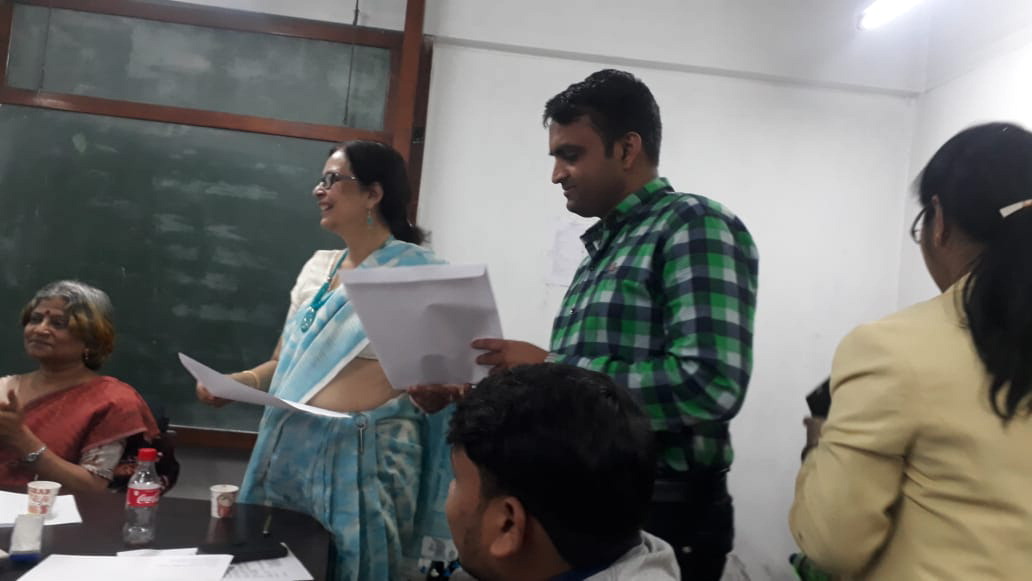Cycle 8 (2019 Deadline)
Conversion from intermittent to continuous water supply (24 x 7) through public-private partnership (PPP): investigating governance and sustenance issues in Karnataka, India
PI: Nayanatara Nayak (nsn.cmdr@gmail.com, nsnayanatara@yahoo.com), Centre for Multi-Disciplinary Development Research (CMDR), in partnership with Karnatak University, Dharwad
U.S. Partner: Emily Kumpel, University of Massachusetts, Amherst
Project Dates: January 2020 - December 2022
Project Overview
The World Bank's support for Continuous Water Supply (CWS)/24x7 in Karnataka's cities rests on agreements with the state government. While the CWS pilot project succeeded in Hubli-Dharwad, questions persist about whether private sector involvement enhances urban water service delivery in terms of availability, quality, pressure, new connections, maintenance, non-revenue water reduction, billing, and fee collection upon city-wide expansion. Does 24x7 supply address equity and sustainability concerns? Does it reduce waterborne diseases? Does the public-private partnership (PPP) model enhance municipal service quality and capacity? Has 24x7 led to conflicts with traditional water institutions, affecting implementation and scaling? These queries guide the proposed study. Jayaramu et al.'s (2015) comparison of CWS and Intermittent Water Supply (IWS) in Hubli-Dharwad highlighted higher customer satisfaction with CWS regarding water quality, continuity, quantity, and pressure, contrasting with dissatisfaction under IWS. Moreover, a draft report on environmental and social impacts of CWS in Hubli-Dharwad noted customer satisfaction among daily wage laborers in 24x7 zones, who no longer needed time off work to fetch water. Conversely, Burt and Ray (2014) found that Hubli-Dharwad's 24x7 system did not meet anticipated expectations.The PEER study used empirical data from urban households and secondary sources including municipal bodies, private operators, financial institutions, and water boards. It aimed to elucidate these issues and contribute to global debates on continuous water delivery. Final Summary of Project Activities
 | | Dr. Narayan Billava (center, in plaid shirt) at the 39th Annual Conference held at Centre for Urban Economic Studies, University of Calcutta, in February 2020 [photo courtesy of Dr. Nayak]. |
Dr. Nayanatara Nayak and her colleagues conducted a comprehensive study of four public-private-partnership (PPP) models for 24x7 water supply during their project. The first model, a "Demo" or "Pilot" project launched in Hubballi-Dharwad, Belagavi, and Kalaburagi in 2008 with World Bank and state government support, has been operational and successful. The second model involves upscaling 24x7 water supply to entire cities, initiated in 2021 with backing from the World Bank, state government, and local municipal bodies, although it faced delays and challenges with labor issues and civic unrest. The success of this model hinges on addressing technical, administrative, and human factor intrusions. The third model in Ilkal town has been highly successful, becoming the second Indian town to achieve 24x7 water supply under the PPP model with support from the Asian Development Bank and local government contributions. This model demonstrates potential for replication with appropriate conditions such as perennial water sources and community involvement. Conversely, the fourth model in Mysuru under the JNNURM in 2013 failed due to contractor non-compliance, leading to a return to intermittent water supply managed by the municipal government's Vani Vial Water Works. The study also focused on the water user payment system, revealing widespread household preference for continuous water supply (CWS) despite higher tariffs. However, scaling up CWS from pilot districts has been slow due to implementation challenges, necessitating further evaluation post-project completion. The pricing policy, influenced more by socio-political factors than economic ones, contributes to unsustainable average water tariffs in India relative to costs, highlighting the need for dynamic pricing aligned with service efficiency. Policy impacts emphasized the advantages of CWS over intermittent supply, including convenience, improved water quality, and higher user satisfaction. However, ongoing concerns persist regarding public confidence in tap water quality and continuity, influencing widespread water treatment and storage practices among residents. The project's dissemination efforts through regional workshops and international conferences enhanced stakeholder awareness and prompted actions to improve water quality testing and management. Dr. Nayak highlighted successful PPP models characterized by strong local leadership, comprehensive metering, and effective demand management, contributing to operational longevity and service expansion. Public funding models also demonstrated viability but require robust local capacity-building to reduce dependence on external funding. Looking ahead, Dr. Nayak plans to continue research collaborations with U.S. partners, leveraging new grants to further investigate water supply sustainability and governance issues. The project's impact underscores the urgency for coordinated efforts among stakeholders to enhance water management practices and support decentralized governance initiatives across India's urban landscapes.
Publications
Sivanna, N., Billava, N., & Nayak, N. (Eds.). (2023). Decentralised Governance and Planning in India: Its Impact on Economic Development and Social Justice. New Delhi: Concept Publishing. ISBN: 9789355942081. Kumpel, E., Billava, N., Nayak, N., & Ercumen, A. (2022). Water use behaviors and water access in intermittent and continuous water supply areas during the COVID-19 pandemic. Journal of Water Health, 20(1), 139–148. https://doi.org/10.2166/wh.2021.184 Billava, N., & Nayak, N. (2022). Tracking scale-up of continuous water services in Hubli-Dharwad, Karnataka: discussion on sustenance issues. Global Journal of Human Social Science, 22(1), 48-55. Retrieved from https://socialscienceresearch.org/index.php/GJHSS/article/view/4018/3909 Kulkarni, A., & Billava, N. (2021). Disparity in Rural Sanitation in Karnataka: Status and Challenges. In V. B. Annigeri, S. V. Hanagodimath, A. R. Kulkarni, & R. S. Deshpande (Eds.), Federalism and Regionalism. Jaipur: Rawat Publications.
Back to PEER Cycle 8 Grant Recipients
| 



